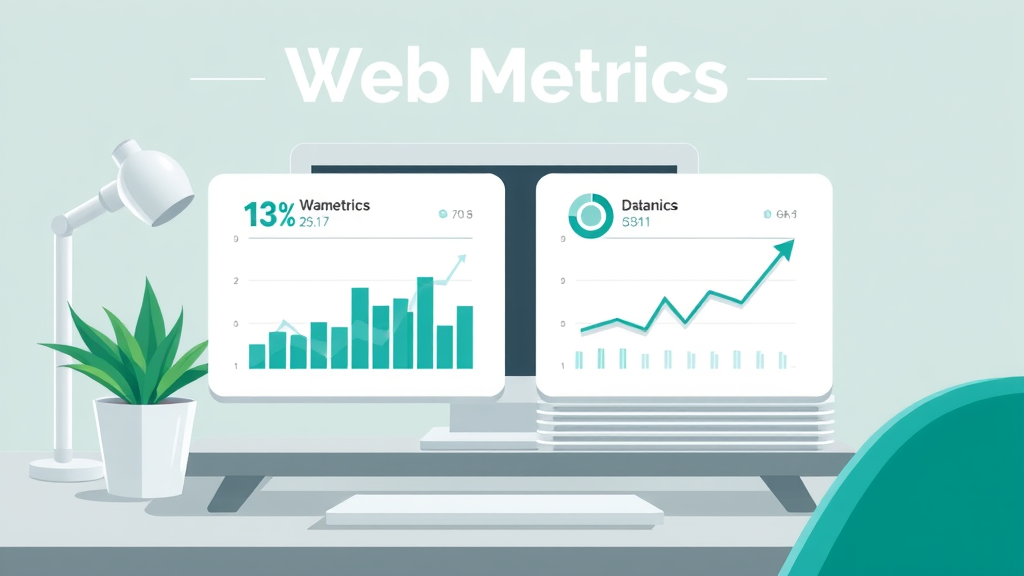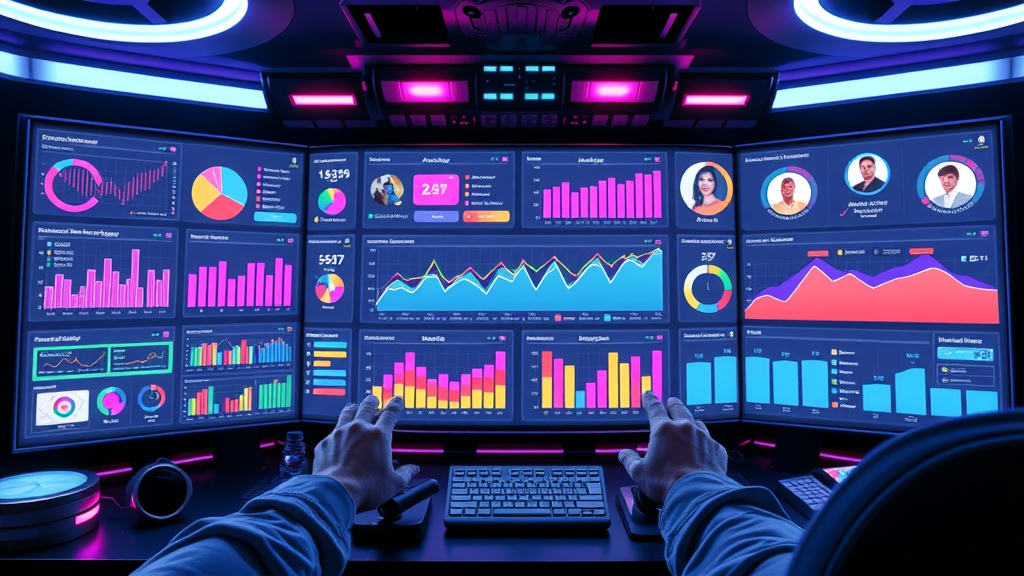Did you know? In 2024, businesses that monitored and optimized their engagement metrics saw an eye-popping 34% increase in customer retention and 48% higher conversion rates across digital channels. As we enter 2025, understanding—and maximizing—engagement metrics has never been more crucial for achieving business goals and creating memorable user experiences.

The Impact of Engagement Metrics: Why They Matter in 2025
The digital marketplace in 2025 operates at a breakneck pace, and traditional vanity metrics alone aren’t enough to measure meaningful success. Engagement metrics provide direct insight into how your target audience interacts with your digital content—whether it’s on social media, your website, or multimedia platforms. With algorithms growing smarter and consumer expectations rapidly evolving, tracking the right engagement metrics is foundational to building high-performing marketing campaigns and improving the user experience. These metrics don’t just reflect interest; they signal intent, satisfaction, and opportunities for conversion. Neglecting them can lead to declining customer engagement, rising churn rates, and ultimately, poor business outcomes.
By focusing on engagement metrics, organizations not only measure user engagement but also continuously refine their approach to maximize returns. Media giants and small businesses alike leverage these critical data points to test, iterate, and personalize the customer journey. In 2025, staying ahead means setting the right metrics to track, adopting best-in-class analytics tools, and translating insights into action faster than ever before.
"In 2025, tracking the right engagement metrics will define your digital success." — Leading Digital Analyst
Engagement Metrics: Startling Statistics to Watch
- Global social media engagement grew by 21% in Q1 2025, outpacing previous years as visual content and short-form video take center stage.
- Brands investing in personalized customer engagement saw a 35% reduction in churn rate and a 27% increase in conversion rates.
- Average time on page for top blogs and landing pages now hovers at 3:18 minutes, up from 2:05 minutes in 2023.
- Interactive bots improved media engagement by 16%, helping brands better segment their user engagement and drive more impactful connections.
- Companies tracking session duration and returning visitor rates report 2.5x higher loyalty in key demographics.

How Engagement Metrics Transform Business and Customer Engagement
Today’s leading brands know that engagement metrics are much more than numbers—they're a clear window into consumer behavior, demands, and satisfaction. By interpreting patterns across social media engagement and user engagement metrics, companies can craft targeted campaigns, optimize their content, and deliver more relevant experiences. This data-driven insight directly influences conversion rates, as businesses quickly identify what drives consumer interaction and what causes drop-offs.
Furthermore, advanced analytics tools now integrate with CRM systems to unify customer engagement data across multiple channels. This holistic view allows organizations to anticipate needs, personalize outreach, and proactively address issues, driving down churn rates and boosting loyalty. In 2025’s hyper-competitive climate, businesses that master engagement metrics will lead the market in both profitability and customer satisfaction.
Social Media Engagement & Media Engagement: The Shifting Paradigms
As algorithms and content consumption change, so do the standards for social media engagement and media engagement. In 2025, brands must focus on not only the volume of interactions—likes, shares, comments—but also the quality of conversations and the duration of user participation. The rise of shoppable content, livestream events, and AI-driven conversations is dramatically changing how users engage across platforms.
On the media side, interactive video ads and podcast sponsorships are boosting user engagement at new touchpoints, making it critical to track advanced metrics to track beyond traditional clicks or page views. Forward-thinking marketers use these insights to test creative formats, target micro-audiences, and measure the precise impact of every media investment.
For brands looking to take their engagement metrics to the next level, understanding the nuances of social media marketing strategies can be a game-changer. Explore proven approaches and actionable tactics in this in-depth guide to social media marketing strategies that drive real growth to further enhance your digital performance.
What You'll Learn About Engagement Metrics
- The core concepts behind engagement metrics and why they matter for business growth
- Which metrics to track for your website, social media, and customer experience platforms
- Best-in-class tools to measure and optimize your engagement metrics in real time
- Step-by-step formulas and real examples for calculating engagement rate, bounce rate, and conversion rate
- Actionable strategies to boost media engagement, lower your bounce rate, and increase user loyalty
- How to set effective KPIs for your marketing campaign and improve both user engagement and customer engagement

Defining Engagement Metrics: Concepts and Core Elements
At their core, engagement metrics are quantitative measures of how audiences interact with your content, products, or brand online. They capture everything from a single page view to user actions like shares, comments, or prolonged session duration on a landing page. Unlike vanity metrics that might just count overall traffic, engagement metrics indicate true interest, connection, and intent among your audience.
Key engagement metrics often include bounce rate, average session duration, and returning visitors, as well as social-specific actions such as likes, shares, and clicks. By regularly monitoring and understanding these metrics, marketers can make informed decisions about content strategy, advertising spend, and platform optimization. The distinction between engagement metrics and other performance metrics is vital, as each type answers different business questions from brand awareness to lead generation to customer retention.
What is an Engagement Metric?
An engagement metric is a data point that measures a user’s active interaction with a brand’s content, product, or service across digital channels. Think of an engagement metric as the bridge between basic traffic (a page view or a visit) and meaningful interaction (liking a post, spending time on a site). Unlike static-lurker stats, these metrics highlight actions: engagement rate, number of comments, shares, repeat visits, or time spent on a product page. They are essential indicators that tell you not just how many people show up, but what they do once they're there—and whether your content meets your business goals.
Engagement metrics can be tracked individually or aggregated to form composite KPIs, helping businesses pinpoint where user experience shines or needs improvement. For digital marketers, product managers, and executives alike, knowing how to interpret these numbers separates digital winners from digital noise.
| Metric Type | Measures | Common Examples | Insights Provided |
|---|---|---|---|
| Engagement Metrics | User Interactions | Likes, Comments, Shares, Session Duration, Time on Page, Returning Visitor | Quality and depth of user engagement, content resonance, loyalty indicators |
| Performance Metrics | Website/Product Outcomes | Conversion Rate, Bounce Rate, Churn Rate, Page Views | Effectiveness of funnels, user retention, sales/conversion efficiency |

Major Types of Engagement Metrics to Track in 2025
The digital ecosystem is more nuanced than ever, and 2025’s top-performing brands are laser-focused on the metrics to track that offer actionable insight. Whether you're honing in on social media engagement or optimizing your website's average session duration, knowing what to measure is the first step toward improvement. Key metrics fall into two main categories: platform-specific (like social media interactions) and platform-agnostic (such as time on page or session duration).
Choosing the right engagement metrics means aligning data collection with your business goals: higher conversion rate, reduced churn rate, or deeper media engagement. As digital journeys grow more complex in 2025, advanced analytics platforms can now knit together these diverse data streams for a unified, actionable view.
Key Social Media Engagement and User Engagement Metrics
- Engagement Rate: Percentage of your audience actively interacting with your content—likes, shares, comments, and clicks combined.
- Likes & Shares: Instantaneous signals of content popularity and reach on social platforms.
- Comments & Replies: Quality interactions indicating a deeper level of user engagement.
- Customer Engagement: Ongoing dialogue with users—from product reviews to direct messages—driving brand loyalty.
- Media Engagement: Interactions with videos, podcasts, or rich media, showing depth of interest and time spent.
Tracking these engagement metrics is essential for any brand that wants to foster loyal followings and assess content performance in real time.
Website Engagement Metrics: From Page View to Session Duration
- Bounce Rate: The percentage of single-page visits with no further action—a key warning sign for issues with relevance or user experience.
- Average Session Duration: How long users stay on your site; a longer average session indicates compelling content and navigation.
- Time on Page: Tracks the engagement for a specific page, such as a landing page or product page.
- Returning Visitor: The number and percent of users who come back, a core metric for loyalty and customer engagement.
- Page Views/Session Duration: Indicates how many pages a user visits per session and the total interaction length.
High-performing websites monitor these metrics alongside conversion rate and funnel progression to ensure every stage delivers value and keeps users engaged.
| Platform | Key Engagement Metrics | Measurement Focus |
|---|---|---|
| Website | Bounce Rate, Average Session Duration, Time on Page, Returning Visitors | User depth, navigation, content effectiveness, loyalty |
| Social Media | Engagement Rate, Likes, Shares, Comments, Follows | Popularity, conversation quality, audience growth and resonance |

Metrics to Track: Setting KPIs for Engagement Metrics
To unlock the full potential of engagement metrics, it’s vital to set specific, measurable KPIs that reflect your organization’s goals. Start by identifying which metrics align most closely with your primary business objectives—be it increasing conversion rates on a landing page, reducing churn rate among customers, or maximizing user engagement on social media.
Leverage leading analytics tools to create custom dashboards and automated reporting. This data-centric approach means teams can respond quickly to shifts in media engagement, fine-tune strategies, and ensure resources are allocated efficiently. Reviewing your KPIs on a regular basis—weekly or monthly—ensures alignment and continuous improvement.
Analytics Tools to Measure Engagement Metrics in 2025
- Google Analytics: Gold-standard for web engagement metrics—track time on page, average session duration, and conversion rate with robust filtering. Its integration with marketing and CRM platforms streamlines ROI tracking, though some advanced social metrics may require integration with other tools.
- Featured Analytics Tool: Modern platforms—like Sprout Social, Amplitude, and Mixpanel—offer deep dives into social media engagement, user experience, and conversion optimization, often using AI to provide real-time insights and trend analysis.
- Strengths: Customizable dashboards, multi-channel reporting, automated alerts for business goals, and visualization tools for easy executive summaries.
- Weaknesses: Learning curve for complex configurations; some tools require significant setup to unify data from website, social, and media engagement sources.
Pro tip: Use a blend of web and social analytics tools to capture a holistic view of customer engagement, optimizing both the journey and the outcome.
PAA: What is a KPI for Employee Engagement?
A KPI (Key Performance Indicator) for employee engagement measures how involved, satisfied, and motivated employees are in their work roles. Common engagement metrics for employees include staff churn rate, internal collaboration rates, response rates to feedback surveys, and participation in company initiatives. High engagement correlates to better customer experience and productivity, while low engagement signals risk for higher turnover and diminished performance. Companies track these KPIs using HR analytics platforms and regular pulse surveys.

Calculating Engagement Metrics: Formulas and Real Examples
Engagement metrics only drive value if measured accurately and consistently. The formulas for calculating key engagement indicators like engagement rate, conversion rate, and bounce rate are foundational for any data-driven team. Understanding how to apply these to your business context will ensure actionable insights and successful marketing campaigns.
Let’s look at the calculations and see how engagement data fuels better decision-making.
Conversion Rate, Engagement Rate, and Bounce Rate: Key Calculations
-
Engagement Rate:
Formula: (Total Engagements ÷ Total Impressions) × 100
Example: If a post has 500 likes, shares, and comments from 10,000 impressions, the engagement rate = (500/10,000) × 100 = 5%. -
Conversion Rate:
Formula: (Number of Conversions ÷ Total Visitors) × 100
Example: 200 purchases from 6,400 product page visitors = (200/6,400) × 100 = 3.13%. -
Bounce Rate:
Formula: (Single-page Sessions ÷ Total Sessions) × 100
Example: Out of 3,000 total site sessions, 600 bounced = (600/3,000) × 100 = 20%.
Use these engagement metric formulas to benchmark and set your metrics to track monthly or quarterly. Automated dashboards in Google Analytics and social analytics platforms can simplify this process even as data sources multiply in 2025.
PAA: How to Calculate Engagement Metrics?
To calculate engagement metrics, start by selecting the precise data you want to analyze—such as total page views, likes, shares, or conversions—over a given period of time. Apply the relevant formulas (engagement rate, conversion rate, bounce rate) as shown above. Always ensure you’re comparing like for like (e.g., weekly vs. monthly data) and adjust for cross-platform differences. Consistent methodology allows for accurate trend spotting and campaign optimization.

Contextualizing Engagement Metrics: Best Practices for 2025
Tracking engagement metrics isn’t enough—they must be interpreted in the right context. In 2025, top brands compare their real-time metrics against industry standards, campaign history, and in-depth user personas. Effective context makes data actionable, not just interesting. Customer engagement and user engagement metrics offer different insights, and distinguishing between them sharpens marketing strategies for both acquisition and retention.
Adopt a culture of regular review, segment your analytics, and always map findings back to your goals—e.g., lowering bounce rate, increasing page views, or lengthening average session duration.
Customer Engagement vs. User Engagement Metrics
- Customer Engagement: Long-term, multi-touch relationships—measured via repeat purchases, loyalty program participation, and NPS surveys. These engagement metrics reflect satisfaction and advocacy.
- User Engagement: Measures all users, including prospects or anonymous site visitors—through session activity, time on page, or content interactions. Provides insight on user experience and media engagement before conversion.
Both sets of metrics to track are critical: customer metrics help strengthen retention and upsells, while user metrics help smooth paths to first purchase or signup.
Industry Benchmarks: What Is a Good Engagement Rate?
Engagement rates vary widely by sector, but data from 2025 shows that a 5–10% engagement rate is competitive for most consumer brands, while 15–20% is exceptional in highly engaged or niche communities. Content type (video, carousel, poll), posting frequency, and platform all influence these averages. Regularly review public benchmark reports, and always set your targets based on your historic highs and your top competitors.
"A 20% engagement rate is exemplary in most industries, but context matters." — Digital Marketing Expert
Your engagement rate will depend on your industry, strategy, and how effectively you motivate users to interact rather than simply consume.
PAA: Is 20% a Good Engagement Rate?
Yes, a 20% engagement rate is considered excellent for nearly every industry in 2025. Most brands average between 2% and 8%, so achieving 20% places you well above typical performance. However, industry averages, content type, and audience expectations can shift these benchmarks. Monitor your trends and always evaluate engagement rates in the context of your goals, seasonality, and previous campaigns for the best results.

Improving Engagement Metrics: Actionable Strategies
Optimizing engagement metrics requires ongoing innovation and sharp execution. With so many digital touchpoints, brands must use a variety of tactics—from content strategy to analytics optimization—to boost interaction, drive conversions, and retain loyal fans. Real improvements are realized through testing, personalization, and consistent measurement.
Let’s explore proven strategies to turbocharge both social media engagement and core website performance in 2025.
Lists: Tactics to Boost Social Media Engagement Metrics
- Personalized Content: Tailor messaging and offers to audience segments based on user behavior and analytics tool insights.
- Audience Segmentation: Use advanced targeting to deliver content at the right time, increasing engagement rates and session duration.
- Optimize Time on Page: Use scroll-depth tracking, embedded media, and calls to action that keep users engaged longer.
- Enhance Session Duration: Build interactive quizzes, live chats, and exclusive gated content for deeper engagement.
- Improve Measurement: Regularly update your analytics tool dashboards for clearer measurement of both quick wins and long-term trends.
Implementing even a few of these strategies can rapidly improve your brand’s visibility, user engagement, and customer loyalty.
Reducing Bounce Rate and Increasing Conversion Rate via Engagement Metrics
- Relevant Landing Pages: Match content to search intent and maintain a focused user experience to reduce bounce rate.
- Clear Value Propositions: Place value front-and-center on your landing page and product page to boost conversion rates.
- A/B Testing: Experiment with headlines, images, and CTAs using your analytics tool for data-driven improvements.
- Streamlined Navigation: Reduce friction for key paths through your site, increasing page views per session duration and guiding visitors to conversion-focused actions.
- Continuous Feedback Loops: Gather user feedback and iteratively enhance your digital presence, informed by ongoing user engagement analysis.
Adopting these best practices will lead to a healthier sales funnel, higher quality engagement, and ultimately, stronger business outcomes.

Frequently Asked Questions: Engagement Metrics in 2025
-
What are the most important engagement metrics to track in 2025?
Focus on a mix of engagement rate, session duration, bounce rate, returning visitors, and media engagement, depending on your primary channels and goals. -
Which analytics tools are best for measuring engagement?
Google Analytics remains a leader for site data; for social media engagement, consider Sprout Social or Buffer, with Amplitude or Mixpanel for in-depth user experience analysis. -
How can I tell if my content is driving real engagement?
Look for rising engagement rates, lower bounce rates, improved conversion rates, and consistent upward trends in session duration and page views. -
What are the trends in customer engagement for 2025?
Hyper-personalized content, real-time audience feedback, interactive video, and AI-driven messaging are setting new benchmarks for customer engagement and loyalty.
Key Takeaways: Engagement Metrics Essentials for 2025
- Set clear KPIs: Tie engagement metrics to business goals, whether growth, retention, or loyalty.
- Monitor regularly: Use leading analytics tools for weekly or monthly reviews.
- Mix your metrics: Track both website and social media engagement for comprehensive insights.
- Act on insights: Turn data into improved user engagement and customer experience.
- Continuously improve: Test, update, and iterate based on what your engagement metrics reveal.

Recommended Resources for Mastering Engagement Metrics
- Google Analytics Official Tutorials
- Sprout Social’s Social Media Engagement Masterclass
- Mixpanel’s Guide to Retention Metrics
- The Ultimate Guide to Social Media Marketing: Strategy, Platforms, Channels, and Tips to Win
- Buffer Blog: Latest Trends in Engagement Metrics
Conclusion: Next Steps for Maximizing Engagement Metrics in 2025
- For more information read The Ultimate Guide to Social Media Marketing: Strategy, Platforms, Channels, and Tips to Win, and How to Build a Winning Plan.
- Need Help? Call Digital Media Marketing at 1-586-997-0001

If you’re ready to elevate your entire digital marketing approach, consider broadening your perspective beyond engagement metrics alone. Discover how integrating content marketing, platform selection, and campaign optimization can drive sustainable growth by reading how to succeed with content marketing and build a winning strategy. This next step will empower you to connect engagement insights with holistic marketing success, ensuring your brand thrives in the evolving digital landscape of 2025 and beyond.
Engagement Metrics Trends: Animated explainer covering key metrics, 2025 predictions, and industry shifts.
 Add Row
Add Row  Add
Add 




Write A Comment